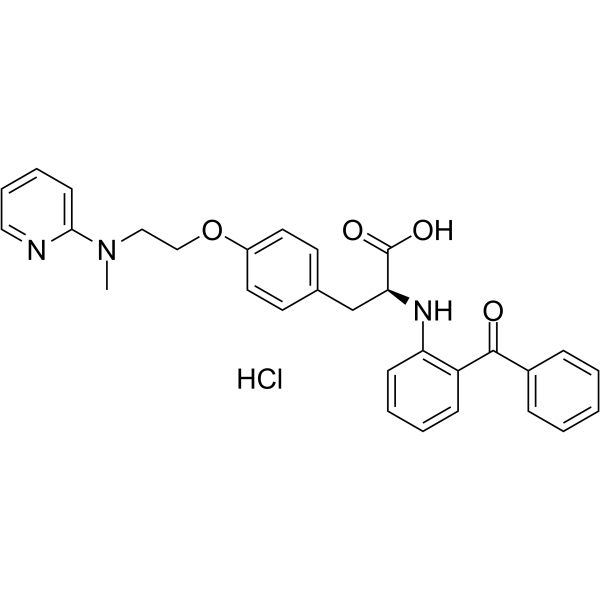GW 1929 hydrochloride
Modify Date: 2025-08-25 03:12:20

GW 1929 hydrochloride structure
|
Common Name | GW 1929 hydrochloride | ||
|---|---|---|---|---|
| CAS Number | 1217466-21-1 | Molecular Weight | 532.030 | |
| Density | N/A | Boiling Point | N/A | |
| Molecular Formula | C30H30ClN3O4 | Melting Point | N/A | |
| MSDS | N/A | Flash Point | N/A | |
Use of GW 1929 hydrochlorideGW1929 hydrochloride is an orally active peroxisome proliferator-activated receptor-γ (PPARγ) agonist with a pKi of 8.84 for human PPAR-γ, and pEC50s of 8.56 and 8.27 for human PPAR-γ and murine PPAR-γ, respectively. GW1929 hydrochloride has antidiabetic efficacy and neuroprotective potential. GW1929 hydrochloride suppresses neuronal apoptosis and shows anti-inflammatory potential[1][2][3]. |
| Name | GW1929 |
|---|---|
| Synonym | More Synonyms |
| Description | GW1929 hydrochloride is an orally active peroxisome proliferator-activated receptor-γ (PPARγ) agonist with a pKi of 8.84 for human PPAR-γ, and pEC50s of 8.56 and 8.27 for human PPAR-γ and murine PPAR-γ, respectively. GW1929 hydrochloride has antidiabetic efficacy and neuroprotective potential. GW1929 hydrochloride suppresses neuronal apoptosis and shows anti-inflammatory potential[1][2][3]. |
|---|---|
| Related Catalog | |
| Target |
hPPARγ:8.84 (pKi) |
| In Vitro | GW1929 hydrochloride is a potent PPAR-γ activator, with pKis of 8.84, < 5.5, and < 6.5 for human PPAR-γ, PPAR-α, and PPAR-δ, and pEC50s of 8.56 and 8.27 for human PPAR-γ and murine PPAR-γ, respectively[1]. GW1929 hydrochloride (10 μM) inhibits TBBPA-induced caspase-3 increase and TBBPA-stimulated LDH release in neocortical cell cultures[2].GW1929 hydrochloride shows significant reduction in the COX-2, iNOS, MMP-9, TNFα and IL-6 levels[3]. |
| In Vivo | GW1929 hydrochloride (0.5, 1, 5 mg/kg, p.o.) highly decreases nonfasted plasma glucose levels in Zucker diabetic fatty (ZDF) rats after treatment for 14 days, and possesses antilipolytic efficacy[1]. GW1929 hydrochloride (1, 5 mg/kg, p.o.) increases glucose-stimulated insuline secretion of β-cell in ZDF rats[1].GW1929 hydrochloride (10 mg/kg body weight) results in amelioration of muscle loss in tumour-bearing mice experimental cachexia[4]. |
| References |
| Molecular Formula | C30H30ClN3O4 |
|---|---|
| Molecular Weight | 532.030 |
| Exact Mass | 531.192505 |
| Appearance of Characters | GW1929 |
| Storage condition | store at -20℃ for one year(Powder) |
| L-Tyrosine, N-(2-benzoylphenyl)-O-[2-(methyl-2-pyridinylamino)ethyl]-, hydrochloride (1:1) |
| MFCD28359221 |
| N-(2-Benzoylphenyl)-O-{2-[methyl(2-pyridinyl)amino]ethyl}-L-tyrosine hydrochloride (1:1) |